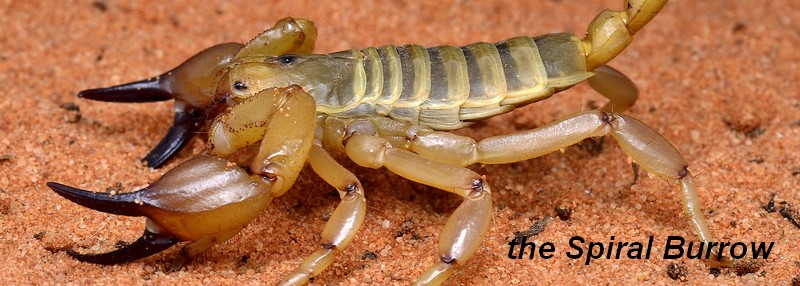
Ecology and Husbandry - Urodacus yaschenkoi
Ecology
The Inland Robust Scorpion shows the most arid adapted morphologies and strategies of all our scorpion fauna. It is found right throughout Australia’s interior from north western Victoria, through South Australia, NT and Western Australia. It constructs deep spiraling burrows in loose sandy soils. A typical Urodacus with a long gestation period of about 18 months and 6 instars to adulthood, which equates to about 4.5 years to maturity and a generation time of 6 years. Mating occurs in spring and early summer months, young are born around March-April. A few weeks after birth they become second instars and disperse within a short distance of the maternal burrow. Clusters of burrows are seen everywhere at this time of the year. Young scorpions dig a shallower burrow than older instars and with each successive molt construct a slightly deeper burrow. All the instars in this species construct a burrow with a spiral section. It is thought the spiral section helps to trap water vapour as in the harsh desert environment water is often scarce for long periods. This species does not drink free water, but gains water from food and is capable of taking water from soil via osmosis.
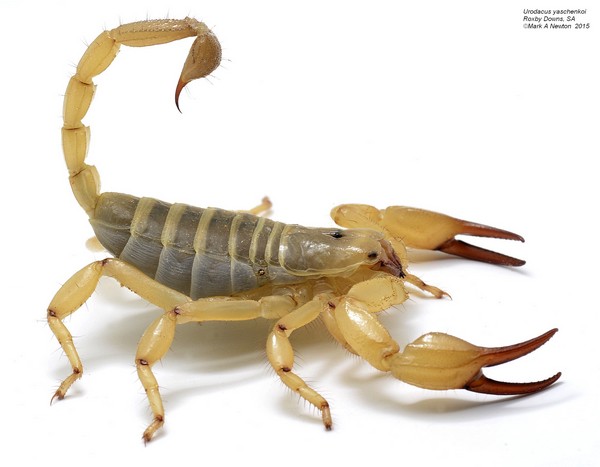 |
Urodacus yaschenkoiA very common species found across inland regions of Australia from NW Victoria to NW Western Australia. Commonly found in association with sand dunes and hummock grasses (Triodia spp), this species is an obligate burrower requiring a false bottom system for the most successful keeping. |
This scorpion is a burrow mouth sit and wait predator that rarely moves any distance from the burrow other than to move soil or in the case of the male to locate a mate. The entrance to the burrow is used as a trap and is well maintained by the scorpion with a steep loose sandy slope. Small arthropods such as ants or spiders have great difficulty in trying to gain traction in the loose soil making it very easy for the scorpion to drag its victim into the burrows entrance chamber.
As a scorpion which spends the greatest part of its life in a humid subterranean environment it has become accustomed to a very narrow range of environmental conditions. Unlike scorpions that live at or near the surface this scorpion rarely faces extreme temperature or humidity swings. The temperature in its burrow during summer is a mild 20-25C day and night with a very high stable humidity nearing saturation. This high water vapor comes from the soils water content, which seems small at only about 1.5% by mass, however it does not take much water to saturate the air of a small volume. The spiral section of the burrow acts to trap air movement from the burrow and hence keep humidity up. Having evolved in this incredibly stable environment is reflected by the fact that this scorpion rapidly loses water through its exoskeleton if left in an atmosphere that is not approaching saturation. We need to be aware of this when setting up a successful captive keeping situation.
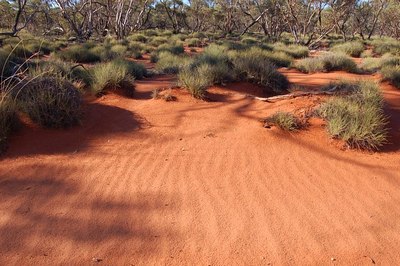 |
HabitatTypical mallee habitat where this species is found in very high densities; water does not pool here, but rather soaks into the substrate resulting in some species such as Urodacus yaschenkoi evolving the ability to draw water from the soil via osmosis. |
Care in Captivity:
Conditions and Housing: This is a relatively difficult species to keep alive in captivity due to it having evolved to occupy a subterranean environment. The keeping methods I describe here are the best answers I have been able to come up with at this time and if followed should give your scorpion the maximum chances of survival.
Method 1: Small sealed containers. One of the problems with this species is that it is not a very surface active scorpion and so using a system that enables it to burrow will mean you may not be able to observe the scorpion very often and when you do it will be at the mouth of its burrow. One way around this is to create a home where the scorpion does not need to burrow. This can be achieved by using a small container that can be sealed shut to water loss. I find the best containers are clear plastic types with screw top lids. You will be able to watch and monitor your scorpion and still give it conditions that will mimic its subterranean burrow. Scorpions burrow to get away from sunlight and find conditions that lower metabolism and reduce water loss. A scorpion’s metabolism increases dramatically with increasing temperature so try to keep this scorpion between 20 and 25C.
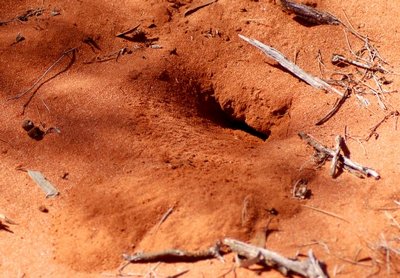 |
Burrow EntranceThis species cleverly uses the burrow mouth for prey capture by regularly clearing away debris and keeping the sand loose in a similar fashion as an ant-lion larvae maintains its pit. The scorpion sits and waits in the mouth of the burrow, when vibrations are detected the scorpion rushes out in the blink of an eye, grabs the hapless victim and pulls it into the steep mouth of the burrow entrance. The steep slope and loose soil aid the scorpion in controlling the victim long enough to inflict its lethal injection. |
You have your tub, your sand and your scorpion. Once the sand has cooled you need to bring the sand up to about 1.5% water by weight. After heating the sand should be close to 0% water. If you have kitchen scales you may be able to weigh the sand, if not then you will be relying on guesswork. If the sand weighs 100grams, add about 1.5 ml of water and thoroughly mix it in. Do not add too much water, especially with adult scorpions. The maximum water content I would suggest is 2%. Pack the sand into the tub and place the scorpion inside. The lid should have a hole drilled into it large enough to get a cricket through. Cover the hole up with wide sticky tape. When you wish to add a cricket, simply lift the tape back and poke the cricket through the hole. Replace the tape if it looks like it might not seal.
Feeding: Feed the scorpion one cricket per week over the warm months and once per month in the cold months. Once a month open the tub and remove any uneaten small bits etc. Any cricket or food item that is not eaten inside 48 hours should be removed. Uneaten food items will encourage mite and fugal growth. Keep the tub out of sunlight and preferably away from any bright lighting, but still give them a day/night cycle with a low level ambient daytime light.
Method 2: False bottom, open air system: The second method is more likely to keep your scorpion alive longer and more likely to allow breeding to take place. This is the result of the scorpion being able to regulate its preferred humidity levels. Any container/tank can be used, but it needs to be relatively deep, deep enough for at least 200mm of desert soil plus some room above ground level. A screen lid is needed for good ventilation. Add about a 25mm layer of rock or washed scoria to the bottom of the tank. In at least one back corner add a plastic tube that stands upright and sits on the base. Have the tube long enough to almost reach the top of the tank, water will be added here. Cut the base of the tube into a v shape to stop it from blocking. Place some fly wire screen across the rock to trap some of the sand and stop it flooding through the rock. Make some desert sand up to about 1.5% water by weight and gradually pack it down over the fly wire, pack it down hard. Make the soil up to at least 200mm deep, preferably more. Once you’ve finished with the soil add any tank inclusions such as mallee roots etc., try to keep inclusions light and not too close to the walls of the container.
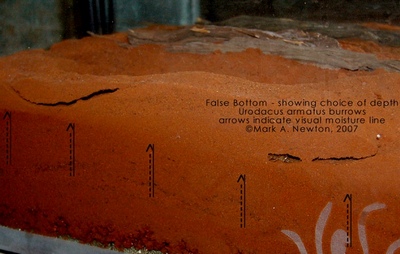 |
False Bottom SystemThe False Bottom System is the best mimic of the natural situation you can give your burrowing scorpion. Water is fed into the base of the tank via a pipe before being drawn up into the soil to create a vertical hydration gradient. This gradient allows the scorpion to regulate its water gain and loss which is a necessary component of fossorial arthropods. The burrows in the above image stop before the soil colour change which is an indicator of water content. |
Maintenance of the false bottom, open air system: This is the tricky part. You need to keep a careful eye on the water level in the sand. You must allow the top 30 - 50mm or so to dry out almost completely. Remember that 1.5% water by weight is very little water. In summer it will be necessary every week to check the soil. I do this visually by looking at the colour of the soil, the darker the soil, the more water it contains. In winter very little water will need to be added. If your scorpion spends a lot of time at the burrow entrance there may be too much water, allow it to dry out a little. If your scorpion rarely appears at the burrow entrance, then you may have it perfect, or it might be too dry, it will be difficult to tell. If your scorpion looks bloated, you have a healthy scorpion; if it looks thin and reacts sluggishly you have an unhealthy scorpion. A scorpion that spends every night out of its burrow searching the tank perimeter most likely is unhappy with the conditions as it is trying to find a better place.